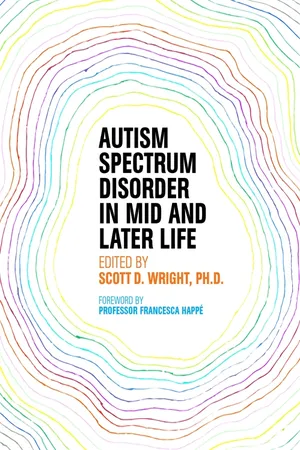![]()
PART I
OVERVIEW
![]()
Chapter 1
ADULTS WITH AUTISM
SPECTRUM DISORDERS
Past, Present, and Future
Kristina J. Cottle, William M. McMahon, and Megan Farley
Introduction
This chapter outlines progress in understanding the nature of autism spectrum disorder (ASD) in adulthood, from the perspectives of research clinicians. The senior author began his career in 1979, before autism was listed in the Diagnostic and Statistical Manual of Mental Disorders, Third Edition (DSM-III) (American Psychiatric Association 1985), when diagnostic criteria did not include the term autism, and when a clinician scientist could know every publication on the topic. A junior co-author is a graduate student just beginning her career during the time of DSM-5, when the volume of new literature on autism is beyond the capacity of a single person. The other co-author bridged past and present by assessing adult outcome of a statewide sample of children identified with DSM-III–diagnosed autism in the 1980s (Farley et al. 2009). Similar to the other chapters in this book, personal perspective, opinion, and hypothesizing will add to what has been proven through replicated research; otherwise, little could be written, especially about ASD in older adults.
In 2012, Eric Fombonne summarized the state of the field in an editorial:
We know next to nothing about people aging with ASD. There are no estimates for longevity in ASD and no data on the quality of life … Whether cognitive decline of the autistic brain, typically characterized by poor connectivity, will follow the same course than in typical aging is simply unknown … The research agenda seems formidable, and targeted funding for research programs, specialized training, and fellowships is likely to be necessary to fill the evidence gap. (Fombonne 2012, p.274)
Early history
The ASD literature initially focused on children, and studies of adults with ASD followed. Since Kanner’s first description of ‘autistic psychopathy’ in 1943 (Kanner 1943), the trajectory of publication of studies of autism in adults has been one of slow initial growth, with a remarkable acceleration in growth over the past three decades (Figure 1.1). A PubMed search for the number of publications per decade using ‘autism’ as the search term returned only 63 publications in each of the first two decades (1940s and 1950s), 397 in the 1960s, 1201 in the 1970s, 1861 in the 1980s, 2836 in the 1990s, and 9766 in the first decade of the millennium. From 2010 to the time of this writing (January 2015), 13,538 new articles on autism are listed, suggesting a sustained high output of literature for the current decade.
The growth of literature on adults with autism has lagged behind the growth of the more general literature (see Figure 1.1). A PubMed search using the combined terms ‘autism’ and ‘adult’ (a (‘Autistic Disorder’[MeSH]) and ‘Adult’[MeSH] OR autis* AND adult b (‘Autistic Disorder’[MeSH]) OR autis*) results in only 46 publications in the first three decades, modest increases in the 1970s and 1980s, and doubling each decade in the 1990s and 2000s. However, the quantity of adult literature seems to be catching up to the more general autism literature, with 2829 citations for adult publications in the past 5 years, compared with 13,538 publications listed for ‘autism’. Similar growth has apparently occurred in educational, occupational, and psychological literature, as have Web-based resources.
Figure 1.1 PubMed search using MeSH and original search terms
As with many syndromes, recognition of individuals with autism occurred slowly in early decades, primarily in specialized academic centers, and was focused on children. There was no mention of autism in the first edition of the DSM in 1952, nearly a decade after Kanner’s seminal description. In 1968, the new DSM-II included ‘childhood psychosis’, but that category was confused with schizophrenia. Infantile autism was finally listed as a separate category in 1980, in DSM-III, with Asperger’s subsequently added in the revision of DSM-III in 1987 (DSM-III-R).
What we know about adults with autism from the literature
Reviews
As demonstrated earlier in this chapter, the amount of literature on adults with ASD is rapidly growing but lags behind the rest of the field. To date, we have a large amount of research, but the heterogeneity of the disorder, small sample sizes, and changes to the diagnostic criteria make it difficult to summarize the current literature base, leaving us with a limited understanding of what these individuals are like in adulthood. Regardless of these limitations, several reviews have recently been published, summarizing the research and providing the field with directions for the future. The reviews cover topics such as outcomes, vocational interventions and services, mental health and psychosocial services, and employment status (Table 1.1).
Studies on adult outcomes begin with Rutter, Greenfeld and Lockyer (1967) publishing adolescent outcomes of individuals with infantile psychosis. Subsequently, Kanner’s follow-up study in 1971 described the outcomes of his original group of 11 individuals, first described in 1943 (Kanner 1971). Rutter et al. (1967) developed ratings for each individual participating in their study in terms of social functioning success. This rating system provided a foundation for subsequent revisions to outcome rating that offered greater detail and improved reliability by the early 2000s. Today, cultural and scientific advances are prompting researchers to continue to determine how best to measure outcome in adults with ASD. In particular, researchers seek to identify ways to describe individual gains over time and individuals’ subjective quality of life (Henninger and Taylor 2013).
Table 1.1 Summary of review literature | |
Author | Focus | Inclusion criteria | Number of studies | Findings | Identified limitations | Recommen
dations for the future |
Taylor et al. (2012) | Vocational in... |

